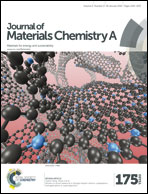A microcontact impedance study on NASICON-type Li1+xAlxTi2−x(PO4)3 (0 ≤ x ≤ 0.5) single crystals
Abstract
We successfully demonstrated the applicability of microcontact impedance spectroscopy (MC IS) on Li+ conducting solid electrolytes and measured the Li+ bulk conductivity (σb) of LiTi2(PO4)3 (LTP) and Li1+xAlxTi2−x(PO4)3 (LATP) single crystals independent of microstructural effects (e.g., grain boundaries, pores, and density). The crystals had a size of about 100 μm in each direction and crystallized with NASICON-type structure (R![[3 with combining macron]](https://www.rsc.org/images/entities/char_0033_0304.gif) c). Finite element calculations were performed to validate the impedance data analysis. A strong increase in σb in the order of three magnitudes (3.16 × 10−6 to 1.73 × 10−3 S cm−1) was found after incorporating 0.1 mol Al3+ per formula unit into LTP. Moreover, since the crystal structural changes are almost linear in the LATP system up to x = 0.5, the increase of σb is most probably related to additional Li+ sites at the M3 (36f) position. The additional Li+ leads to a displacement of Li+ occupying the M1 (6b) sites towards the nearest-neighboring M3 position, and therefore opens the fast-conducting pathway within the NASICON structure. A significant change in σb was also observed as the Al3+ content further increased (x = 0.1 to 0.5). The highest σb value of 5.63 × 10−3 S cm−1 was obtained for samples with x = 0.4.
c). Finite element calculations were performed to validate the impedance data analysis. A strong increase in σb in the order of three magnitudes (3.16 × 10−6 to 1.73 × 10−3 S cm−1) was found after incorporating 0.1 mol Al3+ per formula unit into LTP. Moreover, since the crystal structural changes are almost linear in the LATP system up to x = 0.5, the increase of σb is most probably related to additional Li+ sites at the M3 (36f) position. The additional Li+ leads to a displacement of Li+ occupying the M1 (6b) sites towards the nearest-neighboring M3 position, and therefore opens the fast-conducting pathway within the NASICON structure. A significant change in σb was also observed as the Al3+ content further increased (x = 0.1 to 0.5). The highest σb value of 5.63 × 10−3 S cm−1 was obtained for samples with x = 0.4.


 Please wait while we load your content...
Please wait while we load your content...